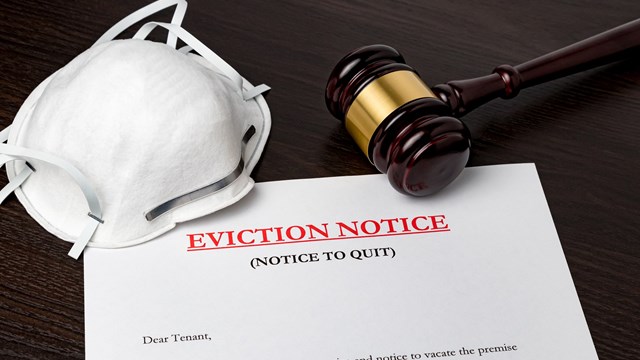While most residential buildings in the city are either purely rental or purely co-op/condo, there are many co-op and condo buildings that are home to rental tenants. This usually is the result of the building converting from rental to co-op or condo, or of shareholders or unit owners renting their units for a period of time or as a source of income.
Conflicts can sometimes arise in mixed-ownership buildings because of the different rules and standards that may apply to rental tenants and shareholder/owners, respectively. Some fully-converted co-ops—most, in fact—discourage or forbid outright the subletting of shareholder apartments, for the very reason that having a sub-set of residents in the building who are not necessarily bound by the same rules and regulations as fully-vested shareholders can lead to problems and conflict.
The Case of Mrs. Smith
In most cases, city law requires that any rental tenant who is unable or unwilling to buy their apartment in a converting building be allowed to stay in the apartment. Consider the fictional Mrs. Smith. In 1973, Mrs. Smith moved into her lovely five-room apartment on the Upper West Side of Manhattan. A few years later, the building converted into a co-op, but Mrs. Smith opted not to purchase her unit. Since then, Mrs. Smith has been paying far below market rent to the sponsor of the building’s remaining unsold shares, who is for all practical purposes, her landlord.
According to Andrew Brucker, an attorney with the Manhattan-based law firm of Schechter & Brucker PC, “When a rent-stabilized or rent-controlled tenant—sometimes called a ‘statutory tenant’—does not purchase their apartment when their building is converted to cooperative ownership by its owner, the statutory tenant retains his or her right to remain in their apartment.”
Mrs. Smith’s rent—while far less than the monthly maintenance fees paid by the residents who bought their apartments during the conversion—is put toward building maintenance and use of the amenities, which includes a beautiful roof garden that Mrs. Smith enjoys visiting every day.
Mrs. Smith is what’s known as a rent-stabilized tenant. Rent stabilized tenants are protected from sharp increases in rent by city-mandated, incremental rent increases, and have the right to renew their leases. The Rent Guidelines Board sets the allowable percentage increase for renewal leases each year. The board met in early May and took a preliminary vote, approving 3 to 6.5 percent increases on one-year leases, and 5 to 8.5 percent increases on two-year leases. The final vote is tentatively scheduled for June 27th.
According to www.housingnyc.com, New York City’s system of rent regulation was enacted in 1969 when rents were rising sharply in many post-war buildings. The system has been extended and amended frequently, most recently in March 2006when New York City Mayor Michael Bloomberg signed legislation that extends the city’s rent stabilization law for another three years.
Another subset of rental tenants in otherwise owner-occupied buildings are rent-controlled tenants. Rent-controlled tenants fall under a policy that applies to residential buildings constructed before February 1947 in municipalities that have not officially declared an end to the postwar rental-housing emergency. For an apartment to be under rent control, the tenant (or their successor) must have been living in that apartment continuously since before July 1, 1971.
When a rent-controlled apartment becomes vacant, it either becomes rent stabilized, or—if it is in a building with fewer than six units—is generally removed from regulation. The unit can then be sold, which is what our fictional Mrs. Smith’s building sponsor/landlord hopes he’ll be able to do one day with Mrs. Smith’s apartment—ultimately earning him a tidy profit.
And finally, says Paul Gottsegen of Halstead Properties in Manhattan, there are also co-op and condo sub-tenants, whose landlords are not building sponsors, but rather individual shareholders and unit owners. “These are renters subleasing apartments from the owners of co-op and condo units,” says Gottsegen, and they’re an entirely different group than the pre-conversion rent-stabilized or rent-controlled tenants.
A Source of Tension?
You might think that a hodgepodge of renters and owners under one roof with disparate fee scales might cause tension or even resentment among building residents, but fortunately, Gottsegen says that’s actually pretty far down the list of things that can go awry with rental tenants in owner-occupied buildings. The reason for that is fairly simple—one way or another, the money owed to the building gets paid.
According to Brucker, “The statutory tenant pays her rent—which is regulated—to the sponsor, who owns the apartment, and the sponsor in turn pays the maintenance on the apartment to the cooperative corporation. Quite often, the regulated rent is lower than the maintenance. In fact, this is one of the reasons why the tenant did not buy the apartment: why pay for an apartment and pay a higher amount each month? The difference is sometimes called the sponsor’s “shortfall” and the loss is absorbed by the sponsor.
While “absorbing loss” is not something that most of us would consider a great business proposition, Brucker says that in most cases, the sponsor has made so much money on the conversion that this loss is just considered a cost of doing business.
“Also,” adds Brucker, “the sponsor might sell these unsold shares to an investor, which not only cuts off each month’s shortfall, but puts money in the sponsor’s pocket—though certainly at a lesser price than if the apartment was vacant.
In the case of rent-controlled or rent-stabilized tenants, the “shortfall” disappears when the statutory tenant leaves (or dies). At that point, the sponsor may charge a fair market rental, which is typically much higher than the maintenance. Or, since the sponsor is not legally bound to get permission from the co-op board before selling or transferring his unsold shares, if he likes he can sell the cooperative apartment to someone else, and certainly profit from that transaction.
Consider again our hypothetical scenario with Mrs. Smith. Throughout the years, Mrs. Smith’s 20-story building has been improved and upgraded. Today, another lovely five-room apartment just like hers can fetch more than $1 million—maybe a lot more. Suppose new owners, a Mr. and Mrs. Williams, just moved in. They’re a career-oriented couple that pays a hefty mortgage plus $1,500 per month for maintenance—a far cry above what Mrs. Smith is paying out for her expenses. There’s no disparity when it comes to the co-op’s bottom line however, because any shortfall in Mrs. Smith’s rent-to-maintenance equation is taken up by the sponsor—so her apartment pulls its own financial weight, if you will.
Privileges and Limitations
Although renters live in the same building as owners or shareholders, they are generally limited when it comes to attending shareholder meetings and sometimes using various amenities.
“The business of the shareholder meetings is with the shareholder, not the renter,” says Marolyn Davenport, senior vice president of The Real Estate Board of New York (REBNY). “The shareholder of the unit would be able to attend a shareholder meeting and convey the information gained there to the rental tenant, but the tenant does not have any right to the meeting.”
And Brucker notes that a shareholder can give a proxy to someone else to attend the meeting, but he says, “it rarely happens.”
“If a shareholder rents out an apartment to a rent-stabilized tenant, however, that tenant is entitled to the same already-existing amenities [that a shareholder would be] all the time,” says Brucker. If the co-op builds or adds a new amenity, the renter may not be allowed to use it.
When Problems Arise
Although all landlords and neighbors wish for such a friendly and quiet renter as Mrs. Smith, not every renter is as sweet. On occasion, renters can be a problem—and sometimes, it’s the sponsors renting to the renters that cause issues.
“If a tenant makes too much noise, it’s up to the [shareholder] or unit owner to stop the tenant from doing whatever it is that’s causing the disturbance,” says Brucker. “The contractual relationship is with the co-op and the owner of the shares. If there’s a problem, the board can go to the shareholder and tell them that they are bringing action against them [because of their problem tenant.] The shareholder/owner must then go to the sub-tenant and straighten it out—or kick the tenant out themselves.”
Gottsegen explains that although noisy tenants are one potential problem for those who rent their units, there are other potential issues that can arise when you blend rent-stabilized and rent-controlled tenants with fully-vested owners under one roof.
“If you have an owner who bought the unit when it converted years ago for say, $400,000 and a recent buyer for, say $1 million, they may have different interests in the building,” says Gottsegen. “As apartments are sold and values keep going up, the new owners may have more interest in making the building better, while the owners of the $400,000 unit may have no interest in advancements. Perhaps they are past retirement and just want to enjoy their home, so these two groups can influence decisions made by the co-op board.”
According to the experts, most sponsors or unit owners who rent out their units include language in their tenants’ leases mandating that the tenant abide by the co-op’s rules and regulations or risk eviction. When a sponsor’s or a unit owner’s rental tenant breaks the building’s rules, the corporation must give notice to the sponsor or the unit owner—not the rental tenant. After all, the cooperative corporation does not have a lease or any other document with the rental tenant, but it certainly does have a covenant with the sponsor/owner. If the problem is not remedied, the cooperative corporation does have the right to sue the sponsor, and even terminate the proprietary lease of the landlord shareholder.
When the issue is the sponsor and not necessarily the rental tenant themselves, it can get a little more complicated, says Brucker.
“In the event that the sponsor refuses to pay maintenance—although his tenant is paying him rent—there are two things that a board of a cooperative corporation can do. First, they can bring a non-payment action against the sponsor and hopefully foreclose on the apartment. This may not be the greatest solution, because if no one purchases the unit at the foreclosure sale, and the cooperative corporation purchases it, they can only collect the statutory rent from the tenant. Thus financially, this is not a great result, except for the fact that the cooperative corporation now would own an asset that certainly would be worth much more when the tenant moves out.”
Brucker says that the second action that the cooperative corporation might consider is set forth in the General Business Law, which allows the cooperative corporation to collect the rent from the tenant. So, even if there is a shortfall, at least some money is being received by the cooperative corporation.
Other Resources
If problems arise between the tenant and the landlord, the Office of Rent Administration (ORA) offers a mediation program that can help resolve common disputes between owners and tenants without the time-consuming paperwork and procedures that are required when formal complaints are filed.
According to www.housingnyc.com/ resources, the program covers four basic types of issues: tenants’ complaints regarding services, tenants’ complaints of owners’ failure to renew a lease, owners’ claims of tenants’ refusal to sign a renewal lease and certain types of tenants’ complaints of harassment.
The mediation program attempts to reach a solution acceptable to both parties within the context of the rent regulatory laws. The process is not open-ended. If a resolution cannot be reached quickly, or within a reasonable period of time, the mediation terminates and the complaint is forwarded for formal docketing and processing. Processing takes 14 days, during which the complaint can be deemed ineligible for several reasons. If the complaint is eligible for mediation, the counselor contacts both parties to see if they agree to cooperate and work through the mediation process, including the correction of any problems. The counselor then follows up to see if the problems have been corrected.
In a city with such a cramped, competitive housing market, it’s no wonder that those lucky enough to have rent-controlled or rent-stabilized apartments want to hold onto them for as long as they can—or that sponsors and unit owners want to use their apartments as money-making investments. Understanding how the landlord-tenant relationship works in a co-op or condo building and negotiating the best terms for those involved is the key to a conflict-free relationship.
Lisa Iannucci is a freelance writer living in Poughkeepsie, New York.







Leave a Comment